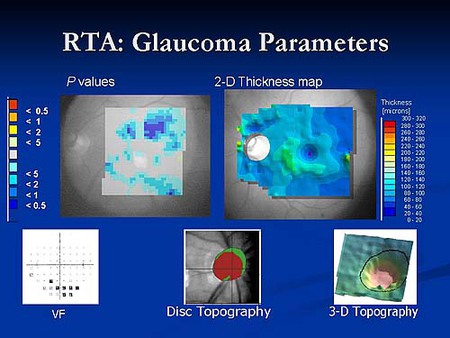Retinal thickness analyzer offers good reproducibility and interpretability
Talia’s rapid scanning instrument is capable of performing both optic disc and macular analysis.
TAMPA, U.S.A. — The Retinal Thickness Analyzer from Talia Technology Inc. is an innovative multipurpose system that combines a digital fundus camera, computerized scanning slit lamp and a retinal thickness analyzer.
“For me, the RTA is the best way to analyze the macula. We have many patients who have macular disease that we need to follow. No one likes to do fluoresceins all the time. With the RTA there are no injections, no side effects, no special technology and no special training for the technician,” said John D. Sheppard, MD, a cornea, external disease and uveitis specialist in Norfolk, U.S.A.
Dr. Sheppard has been using the RTA for the past 2 years to screen and make initial treatment decisions about glaucoma.
“It is also useful in following glaucoma therapy, as well as therapy for macular disease. [It] appears to be quite reproducible. Serial points tend to establish a credible trend. You don’t end up with points all over the map,” he said.
The unit’s interpretability is also a clinical advantage.
“You can apply the findings to the patient’s particular profile and therapy,” he said. “If the macula becomes thicker, you know something’s wrong, and if the macula and nerve fiber layer become thinner you know there has been an atrophic change. If the optic nerve shows more cupping, you know that a particular glaucoma therapy is not working.”
Rapid scanning
Patient scanning time is only 23 seconds with the RTA, and the instrument is suitable for uncooperative patients with rapid eye movement, Dr. Sheppard said.
“You can take all the scans you need,” between 4 and 13 scans per eye, depending on the diagnosis desired, Dr. Sheppard said. “Each scan takes only 0.3 seconds, which is less than the physiologic saccade rate of 0.5 seconds. As an addition to a reasonably busy practice, the RTA can become a routine part of screening for disease, particularly glaucoma, and a routine part of assessment of disease progress or remission. The machine should pay for itself within 8 to 18 months in a fairly busy practice.”
Dr. Sheppard said his staff and patients also appreciate the RTA.
“Showing pictures to patients adds to the explanation of disease and their understanding of disease progress and therapeutic goals,” he said.
|
|
Recent convert
Edward R. Thomas, MD, a glaucoma specialist from Dayton, Ohio, acquired the RTA in January because he was impressed by the device’s reproducibility results and the capability of analyzing the macula and optic nerve.
“The RTA provides good data concerning the retina around the optic nerve. It is also reproducible, and retinal defects are verified by other retinal analyzers on the market today,” he said.
“I find that optical coherence tomography (Zeiss Humphrey) and the Talia render excellent paramacular analysis,” he said. “The instrument is capable of performing both optic disc and macular analysis, which we feel is extremely important in evaluating patients for glaucoma.”
For patients with diabetic retinopathy, the RTA helps identify retinal edema in the macular area for diagnosis and treatment “perfectly,” he said.
The RTA is also capable of paramacular analysis in patients with macular degeneration.
“The device can pick up preclinical defects. [It] does not require as in-depth training as some of the other systems,” he said.
The instrument operates on the principle of laser biomicroscopy, covering a zone of about 20° by 20° around the foveal area, Dr. Thomas said.
“This is an extremely important zone, particularly in glaucoma for analyzing ganglion cell loss,” he added.
Enhanced features
According to officials at Talia Technology Inc., the Israeli company’s U.S. subsidiary, the RTA has been available since the early 1990s, and a commercial unit first became available in the late 1990s. Earlier this year, the company upgraded the software and made some internal hardware changes to provide better images. The software is now more user-friendly for the operator, and the reports have also been changed so they are easier to read. Pseudophakic patients are readily analyzed.
The new reports are also structured to allow progressive tracking of a patient from one report to the next.
Some of the equipment related to the camera has been enhanced for clearer slit images. Company officials said the computer software now has clearer information with which to work. This has resulted in improved reports and improved imaging for the physician and the patient.
For Your Information:
- John D. Sheppard, MD, can be reached at 403 Medical Tower, Norfolk, VA 23507 U.S.A.; +(1) 757-622-2200; fax: +(1) 757-622-9136. Dr. Sheppard does not have a direct financial interest in any of the products mentioned in this article. He is a paid consultant for Talia Technology Ltd.
- Edward R. Thomas, MD, can be reached at 60 Wyoming St., Dayton, OH 45409 U.S.A.; +(1) 937-223-9117; fax: +(1) 937-223-5416. Ocular Surgery News was not able to confirm if Dr. Thomas has a direct financial interest in the products mentioned or if he is a paid consultant for any companies mentioned.
- Talia Technology Inc., can be reached at 4519 George Rd., Suite 120, Tampa, FL 33634 U.S.A.; +(1) 813-887-1917; fax: +(1) 813-887-5909; Web site: www.talia.com.

